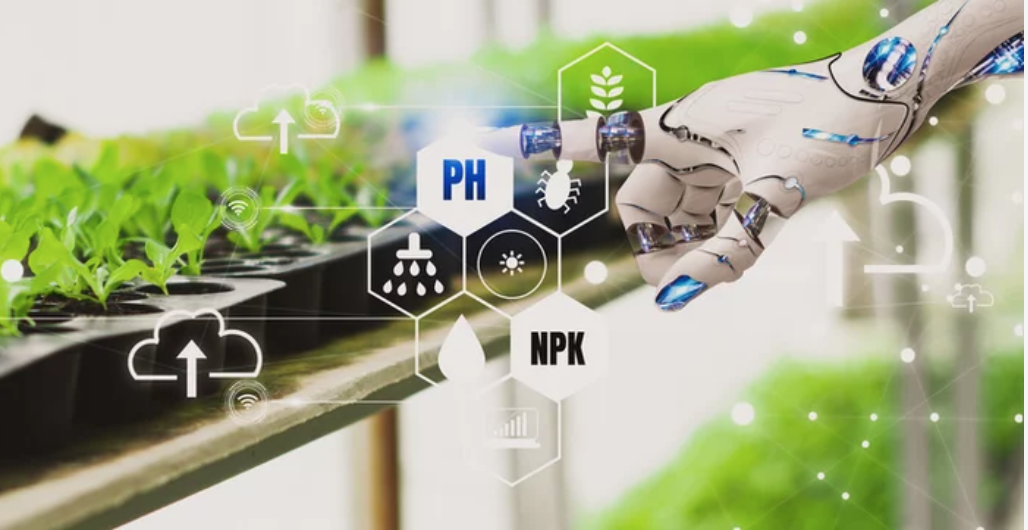“Harnessing the Power of AI to Grow Smarter Crops”.
Introduction
Artificial Intelligence (AI) and Smart Agriculture Technology are two of the most exciting and rapidly growing areas of technology today. AI is the development of computer systems and machines that can think and act like humans, while Smart Agriculture Technology is the use of advanced technologies to improve the efficiency of agricultural production. Both have the potential to revolutionize the way we produce food and interact with our environment. AI can provide unprecedented insights into agricultural data and enable better decision-making, while Smart Agriculture Technology can automate labor-intensive tasks, save water, and increase crop yields. Together, these technologies can help us to produce food more efficiently and sustainably, while also addressing climate change and global food insecurity.
How Artificial Intelligence is Revolutionizing Smart Agriculture
The emergence of Artificial Intelligence (AI) is revolutionizing the way the agricultural sector operates. AI technology is enabling farmers to gain increased efficiency in crop production, improved crop yields, and a better understanding of the environment. This technology provides an array of benefits that are critical to the development of smart agriculture.
One of the most important benefits of AI technology in farming is the ability to monitor and analyze data more efficiently. AI technology enables farmers to access and analyze data on soil conditions, weather, and other environmental factors to determine the best time to plant and harvest crops. This data can also be used to identify the best fertilizers, pesticides, and other inputs needed for maximum crop yields. Additionally, AI can be used to predict future weather patterns and other environmental conditions that could affect crop growth. This helps farmers to plan accordingly and prepare for any potential risk factors.
Another key advantage of AI technology in agriculture is the ability to automate many of the labor-intensive tasks associated with farming. AI can automate many of the manual tasks associated with crop production, such as planting, harvesting, and sorting. This allows farmers to focus on more important tasks, such as marketing and selling their produce. Moreover, AI technology can be used to monitor and manage livestock, providing farmers with real-time data on the health of their animals. This data can also be used to identify disease and pest infestations, enabling farmers to take appropriate action before it is too late.
Finally, AI technology can be used to improve the sustainability of agricultural production. AI can be used to identify areas of land that are suitable for crop production, reducing the amount of land needed for farming. Additionally, AI technology can help farmers reduce their use of water and other resources, enabling them to reduce their environmental impact.
AI technology is revolutionizing the way smart agriculture is being practiced. The technology provides a range of benefits that are critical to the success of agricultural production, from improved efficiency to increased sustainability. By utilizing this technology, farmers can improve their productivity and profitability while also reducing their environmental impact.
Exploring the Benefits and Challenges of Implementing Smart Agriculture Technology
The implementation of smart agriculture technology has revolutionized the agricultural industry, offering a wealth of both benefits and challenges for those involved. In this essay, we will explore the significant advantages and drawbacks of implementing smart agriculture technology in modern farming.
The primary benefit of smart agriculture technology is the ability to improve crop yields. By making use of sophisticated sensors to monitor soil health and weather conditions, farmers are able to better understand how to optimize their land for maximum crop yield. Additionally, with the use of automated irrigation systems and robotic harvesters, farmers can maximize their efficiency and reduce labor costs. This is particularly beneficial to small-scale farmers who are limited in their resources.
Another advantage of smart agriculture technology is that it can significantly reduce the environmental impact of farming. Automated irrigation systems can be used to precisely measure the amount of water used, reducing wastage and the risk of soil erosion. Smart sensors can also be used to monitor the health of the soil, alerting farmers when they need to adjust their farming practices to ensure the land remains healthy.
Despite these advantages, the implementation of smart agriculture technology does come with some challenges. Firstly, the cost of purchasing and maintaining the necessary equipment can be prohibitive for some farmers, particularly those without access to financing. Additionally, as the technology is relatively new, there is a lack of understanding and training among farmers on how to use it. Finally, the possibility of cyber-attacks or other malicious actors exploiting the technology poses a security risk to farmers’ data.
In conclusion, while smart agriculture technology has the potential to revolutionize the agricultural industry, there are a number of benefits and challenges that must be considered before implementing the technology. By understanding the advantages and drawbacks of this technology, farmers can make informed decisions about how to best use it to maximize their yields and ensure their farms are both sustainable and secure.
How Machine Learning is Helping Farmers Increase Crop Yields
Farmers have long sought to increase crop yields in order to maximize their profits and ensure their businesses remain viable. In recent years, advances in machine learning have enabled farmers to leverage this technology to increase their crop yields in ways that were not previously possible. This article will examine how machine learning is helping farmers increase crop yields and why it is an important tool for improving agricultural practices.
First, machine learning can be used to analyze vast amounts of data about crops, such as soil composition, weather conditions, and pest infestations. This data can be used to inform farmers about the optimal conditions for their crops and help them make better informed decisions regarding planting, fertilizing, and harvesting. For example, machine learning can help farmers determine the best time to plant, the ideal amount of fertilizer to use, and which crop varieties will yield the highest results. By leveraging this information, farmers can better tailor their practices to their local conditions, leading to increased crop yields.
Second, machine learning can be used to identify and diagnose plant diseases. By analyzing data associated with plant health, machine learning algorithms can detect early signs of disease and inform farmers of the appropriate preventive measures. This can help farmers address issues quickly and efficiently, leading to fewer crop losses due to disease.
Finally, machine learning can be used to optimize the use of agricultural inputs such as fertilizers, water, and pesticides. By analyzing data about previous crop yields and trends in crop health, machine learning algorithms can determine the optimal amount of input required for a particular crop. This can help farmers reduce the amount of inputs used, leading to cost savings and reduced environmental impact.
Overall, machine learning is an invaluable tool for helping farmers increase crop yields. By providing insights into soil composition, weather patterns, pest infestations, and plant diseases, machine learning algorithms can help farmers make more informed decisions about their cropping practices. Similarly, machine learning can help farmers optimize the use of agricultural inputs, leading to reduced costs and improved environmental outcomes. As such, machine learning is an important tool for improving the livelihoods of farmers and contributing to global food security.
What Farmers Need to Know About the Growing Role of AI in Agriculture
The application of artificial intelligence (AI) in agriculture is rapidly evolving. As a result, farmers must be aware of the implications of this technology in order to remain competitive and capitalize on its potential. AI can be used in a variety of ways to improve agricultural processes, from optimizing crop yields to managing herds. This article will discuss the growing role of AI in agriculture and the implications for farmers.
One of the primary ways AI is being used in agriculture is to improve crop production. Through the use of algorithms, AI can be used to analyze the data generated from crop production in order to optimize yields. This data can be used to identify areas of inefficiency, such as soil composition or irrigation practices, and suggest changes to improve output. By utilizing AI, farmers can maximize their yields and make more informed decisions about crop management.
AI can also be used to manage herds. Livestock management is a labor-intensive process, and AI can be used to automate many of these tasks. AI-powered systems can monitor the health of animals, identify potential diseases, and alert farmers to any potential issues. This automation can reduce the time and effort needed to manage herds, allowing farmers to focus on other tasks.
In addition, AI can be used to monitor the environment and alert farmers to any potential issues. AI-powered systems can analyze data from weather sensors, soil sensors, and other sources, and alert farmers to any potential issues. By utilizing this technology, farmers can be better prepared for any environmental changes and take the necessary precautions to protect their crops.
Finally, AI can be used for precision farming. This technology can be used to analyze data from different sources, such as soil, climate, and crop rotation, and provide detailed insights into how to optimize crop production. By using AI, farmers can make more informed decisions about when to plant, when to harvest, and how to manage their land.
Overall, the growing role of AI in agriculture presents both opportunities and challenges for farmers. While AI can be used to improve yields and manage herds more efficiently, farmers must be aware of the implications of this technology in order to remain competitive and capitalize on its potential. By understanding the potential of AI, farmers can make better decisions about the use of this technology in their operations.
Conclusion
In conclusion, Artificial Intelligence and Smart Agriculture Technology have a great potential to revolutionize the agricultural industry in the near future. With the growth of the internet of things, data-driven decisions, and the use of robotics, AI-driven solutions and smart farming technologies are being developed to make the farming industry more efficient, cost-effective, and sustainable. AI-driven solutions and smart farming technologies will help increase yields, reduce costs, and make farming more efficient. AI-driven solutions and smart farming technologies also have the potential to revolutionize the way we interact with our food, from harvesting to delivery. With the right investments, AI-driven solutions and smart farming technologies can be the key to a more efficient and sustainable agriculture sector.


